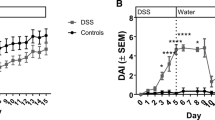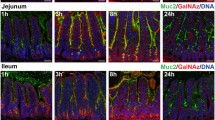Abstract
Objectives
Changes in extracellular matrix glycosaminoglycans (GAGs) of the intestinal mucosa have been associated with inflammatory bowel disease. The aim of the present study was to follow the changes in GAGs metabolism during the progression from non-inflamed to inflamed intestinal colon of patients with Crohn’s disease (CD), using direct biochemical analysis and specific immunohistochemistry against chondroitin/dermatan sulfate and heparan sulfate.
Design and methods
The content of GAGs from inflamed and non-inflamed colon of eight patients with active CD was estimated by uronic acid per dry weight of tissue and analyzed by agarose gel electrophoresis and ion-exchange chromatography. Intestinal sections were stained using antibodies against dermatan sulfate/chondroitin 4-sulfate (DS/CS), heparan sulfate (HS), and ICAM-1 (CD54), and analyzed by confocal microscopy.
Results
There was a reduction in the amount of GAGs in the non-inflamed colon of patients with CD. In the inflamed colon, HS, CS and DS showed increased concentrations compared with the non-inflamed colon. GAGs showed a diffuse distribution in the lamina propria and in the basement membrane of both inflamed and non-inflamed mucosa of patients with CD.
Conclusion
We observed a marked reduction in GAGs with altered patterns of distribution in the non-inflamed colon of patients with CD. The increase in the synthesis of GAGs observed in the inflamed colon may be a compensatory mechanism for the restoration of the integrity of the intestinal mucosa.





Similar content being viewed by others
Notes
Numbers represent the median with ranges. Total content of GAGs obtained from the non-inflamed CD are significantly different from those of both the inflamed areas of CD (*p< 0.02) and controls (**p<0.007).
References
Pender SLF, Breese EJ, Günther U et al (1998) Suppression of T cell-mediated injury in human gut by interleukin 10: role of matrix metalloproteinases. Gastroenterology 115:573–583
Pender SLF, Tickle SP, Docherty AJP, Howie D, Wathen NC, MacDonald TT (1997) A major role for matrix metalloproteinases in T cell injury in the gut. J Immunol 158:1582–1590
Schuppan D, Riecken EO (1990) Molecules of the extracellular matrix: potential role of collagens and glycoproteins in intestinal adaptation. Digestion 46:2–11
Malik AB, Lynen JL, Cooper JA (1989) Endothelial barrier function. J Invest Dermatol 93:62S–67S
Powers MR, Blumenstock FA, Cooper JA, Malik AB (1989) Role of albumin arginyl sites in albumin-induced reduction of endothelial hydraulic conductivity. J Cell Physiol 141:558–564
Rosenzweig LJ, Kanwar YS (1982) Removal of sulfated (heparan sulfate) or non-sulfated (hyaluronic acid) glycosaminoglycans results in increased permeability of glomerular basement membrane to 125I-bovine serum albumin. Lab Invest 47:177–184
Sunergren KP, Fairman RP, deBlois GG, Glauser FL (1987) Effects of protamine, heparanase and hyaluronidase on endothelial permeability and surface charge. J Appl Physiol 63:1987–1992
Comper WD, Zamparo O (1990) Hydrodynamic properties of connective tissue polysaccharides. Biochem J 269:561–564
Comper WD, Laurent TC (1978) Physiological function of connective tissue polysaccharides. Physiol Rev 58:255–315
Kjellén L, Lindahl U (1991) Proteoglycans: structures and interactions. Annu Rev Biochem 60:443–475
Lindahl U, Höök M (1978) Glycosaminoglycans and their binding to biological macromolecules. Annu Rev Biochem 47:385–417
Ahrenstedt O, Knutson L, Hallgren R, Gerdin B (1992) Increased luminal release of hyaluronan in uninvolved jejunum in active Crohn’s disease but not in inactive disease or in relatives. Digestion 52:6–12
Filipe MI, Dawson I (1970) The diagnostic value of mucosubstances in rectal biopsies from patients with ulcerative colitis and Crohn’s disease. Gut 11:229–234
Murch SH, MacDonald TT, Walker-Smith JA, Levin M, Lionetti P, Klein NJ (1993) Disruption of sulfated glycosaminoglycan in intestinal inflammation. Lancet 341:711–714
Sheehan DG, Jervis HR (1976) Comparative histochemistry of gastrointestinal mucosubstances. Am J Anat 146:103–132
Cardoso LEM, Mourão PAS (1994) Arterial connective tissue alteractions in thalassemia major: a biochemical study of a case with severe iron overload. Braz J Med Biol Res 27:509–514
Harvey RF, Bradshaw MJ (1980) Measuring Crohn’s disease activity. Lancet 1:1134–1135
Seldenrijk CA, Morson BC, Meuwissen SG, Schipper NW, Lindeman J, Meijer CJ (1991) Histopathological evaluation of colonic mucosal biopsy specimens in chronic inflammatory bowel disease: diagnostic implications. Gut 2:1514–1520
Bitter T, Muir HM (1962) A modified uronic acid carbazole reaction. Anal Biochem 4:330–334
Dietrich CP, Dietrich SMC (1976) Electrophoretic behaviour of acidic mucopolysaccharides in diamine buffers. Anal Biochem 70:645–647
Pavão MSG, Aiello KRM, Werneck CC et al (1998) Highly sulfated dermatan sulfates from ascidians. Structure versus anticoagulant activity of these glycosaminoglycans. J Biol Chem 273:27848–27857
Shievely JE, Conrad HE (1976) Formation of anhydrosugars in the chemical depolymerization of heparin. Biochemistry 15:3932–3942
Pender SL, Lionetti P, Murch SH, Wathan N, MacDonald TT (1996) Proteolytic degradation of intestinal mucosal extracellular matrix after lamina propria T cell activation. Gut 39:284–290
Tsara ME, Papageorgacopoulou N, Karavias DD, Theocharis DA (1995) Distribution and changes of glycosaminoglycans in neoplasias of rectum. Anticancer Res 15:2107–2112
Alini M, Losa GW (1991) Partial characterization of proteoglycans isolated from neoplastic and nonneoplastic human breast tissues. Cancer Res 51:1443–1447
Iozzo RV, Wight TN (1982) Isolation and characterization of proteoglycans synthesized by human colon and colon carcinoma. J Biol Chem 257:11135–11144
Kovalszky I, Pogang G, Molnar G et al (1990) Altered glycosaminoglycan composition in reactive neoplastic human liver. Biochem Biophys Res Commun 167:883–890
Rapraeger AC, Krufka A, Olwin BB (1991) Requirement of heparan sulfate for bFGF-mediated fibroblast growth and myoblast differentiation. Science 252:1705–1708
Szabo S, Kusstatscher S, Sakoulas G, Sandor Z, Vincze A, Jadus M (1995) Growth factors: new ‘endogenous drugs’ for ulcer healing. Scand J Gastroenterol 210:15–18
Klagsbrun M, Baird A (1991) A dual receptor system is required for basic fibroblast growth factor activity. Cell 67:229–231
Day R, Forbes A (1999) Heparin, cell adhesion, and pathogenesis of inflammatory bowel disease. Lancet 354:62–65
Penc SF, Pomahac B, Winkler T et al (1998) Dermatan sulfate released after injury is a potent promoter of fibroblast growth factor-2 function. J Biol Chem 273:28116–28121
Penc SF, Pomahac B, Eriksson E, Detmar M, Gallo RL (1999) Dermatan sulfate activates nuclear factor-kappa b and induces endothelial and circulating intercellular adhesion molecule-1. J Clin Invest 103:1329–1335
Acknowledgements
The authors wish to thank the Brazilian foundations FUJB, CNPq and FAPERJ for financial support, and Dr. Henrique L. Lenzi, for the use of confocal microscopy, Department of Pathology, Instituto Oswaldo Cruz.
Author information
Authors and Affiliations
Corresponding author
Rights and permissions
About this article
Cite this article
Belmiro, C.L.R., Souza, H.S.P., Elia, C.C.S. et al. Biochemical and immunohistochemical analysis of glycosaminoglycans in inflamed and non-inflamed intestinal mucosa of patients with Crohn’s disease. Int J Colorectal Dis 20, 295–304 (2005). https://doi.org/10.1007/s00384-004-0677-2
Accepted:
Published:
Issue Date:
DOI: https://doi.org/10.1007/s00384-004-0677-2




